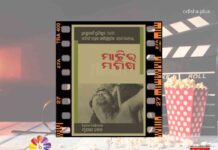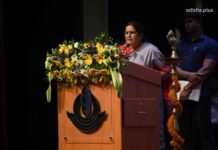Bhaskar Parichha

There is a poignant tale to this book. Before the manuscript could see the light of the day, its author Annie Ali Khan died in an accident in Karachi last year. Annie was just thirty at the time of demise. A brilliant journalist with a master’s degree in journalism from Columbia University, she was a writer, a photographer with works published in Caravan, Marie Claire and The Herald. She was the photojournalist on the national-award-winning story on truck art.
In the epilogue, Annie’s friend Manan Ahmed Asif writes equally touchingly about the events leading to the final publication of the book. Asif calls her a fearless reporter of Pakistan and no journalist before had dared to do a newspaper story on a Hindu Pilgrimage in Pakistan. It in fact from this article is that the book has originated.
‘Sita Under the Crescent Moon – A Woman’s Search for Faith in Pakistan’ is a dazzling account of a tradition simply for the reason that it combines spirituality with travel. The blurb of the book says it all: ‘In present-day Pakistan, in the far corners of Lyari in Karachi, or Hingol in Balochistan, or Thatta in Sindh, tightly knit groups of women keep alive the folklore, songs, and legends of Sati—their name for Sita in the Ramayana.’
Annie traveled with women devotees on pilgrimages to retrace the way they worship the goddess. She followed healers, heretics, seekers, wives, mothers, sisters, grandmothers and believers. These journeys intensely throw light on a veiled and opaque world. With loads of empathy, love, and self-sacrifice, the author listens to the stories of these women. She writes them down – word for word in some cases – capturing their dilemmas, the violence and the outfits they belong to.
Her exploration didn’t stop there. She ate, rested, slept, prayed, and lived with them. She was adopted by some as their own daughter. Some even relied on her knowledge of the world to help show them the way of the government and the benefits therein.
The book shows expressively how worship has changed mind-sets and altered many of the mores of the land. While the sacral sites, made up of clay and thread grant a woman power and autonomy to fight her wretched conditions, the narrative demonstrates the pliability of women and depicts how, under the shadow of militant majoritarianism, women are keeping alive the memories of Sita’s exile, and her ultimate sacrifice.
The travelogue also tells Annie Ali Khan’s own journey. From her memories of Durga in the house of her grandfather’s friend to her own experience before Durga Mata in Hinglaj, the book is a chronicle of a woman in search of healing power. A Hindu Pilgrimage in Balochistan is also the quiescent place of Hingula Devi, locally called Nani Pir. This is one of the 51 Shakti Peethas of Sati, wife of Shiva. Meeting Durga at Hinglaj that inspires her to explore the way of the Satiyan, the seven sacred sisters, and also to look for Sita.’
Examine this: ‘At Hub Chowki, a historic-city-turned-transit-town is now the gateway between Sindh and Balochistan. Those traveling through are greeted by a road sign that reads “Mundra” – a Sanskrit word meaning temple or place of worship or chasm – overshadowed by a larger sign with a new name, proclaiming, in bold Arabic script, “Seerat”, meaning inner beauty, heavenly light hidden from view, veiled. These are the many paths to the sacred and the beautiful that abound in the Islamic Republic of Pakistan. May the goddess protect us!’
Then she delves into the geography of the sub-continent: ‘Hinglaj, in the heart of the province, is as sacred as it is remote. The ancient temple is located along an endless terrain following a coastal route that reaches beyond the Malabar region in south India and extends further up north, past Rajasthan, then the coastal cities of Iran. I read somewhere that the road between the sea-facing shrine of Abdullah Shah Ghazi in the port city of Karachi and the shrine of Haji Ali, half-submerged in the sea in Bombay, was once a route well-traveled by pilgrims of the Sufi order – before the borders got in the way.’
The book is replete with a wide range of socio-political events — the uprising in Balochistan, clashes between Shia and Sunni sects, activities of Jamiat-e-Ulema-e-Islam. There are also cultural references and old-world factoids : about the Odh people specializing in building homes of mud and straw, descriptions of the traditional quilt, ralli, Makli being the city of a hundred thousand graves, women smoking chillum and Capstan cigarettes at shrines, use of “bird water” for cure, hierarchical relationships between the Sindhi and Baloch communities, the Chaaran community, the Meghwars being denied cocaine on grounds of their low caste status, the “Hanging Mela”, the “Ram Bagh” metamorphosing into “Aaram Bagh”, the Benazir Fund and her husband, Asif Ali Zardari, being known as “Mr Ten Percent” for demanding a cut in all governmental deals, and so on.
The three-hundred-page hardbound is dedicated to one of the greatest writers – Quratulain Ali Hyder. ‘Sita under the Crescent Moon’ is a remarkable tribute to Pakistani women who have always been the custodians of small traditions. It is these songs, folktales, and legends that become powerful mediums of transmission of traditions and faith in the absence of higher psychical goals.

Annie’s exploration of faith is again syncretic: ‘I was accompanying a family of yatris on a pilgrimage to the temple, entering the heavily patrolled and policed borders of the province with them. It was also the last night of Navratri, the festival celebrating the victory in the battle of the goddess Durga over a demon buffalo to restore dharma, the order of the cosmos. Sati’s suffering and sacrifice and the joy of her victory were remembered like Moharram, like mohabbat; love in the heart, eternal and ever-flowing like the suffering that was life on earth.’
‘Sita under the Crescent Moon’ is not only breathtaking documentation of a spiritual journey, but it is also a gender- gaze. Strikingly, nationality, community, ethnicity also come up for closer investigation in the book.
Sita under the Crescent Moon
Annie Ali Khan
Simon & Schuster India
818,Indraprakash Building
21, Barakhamba Road
New Delhi – 110001
Rs 599

























